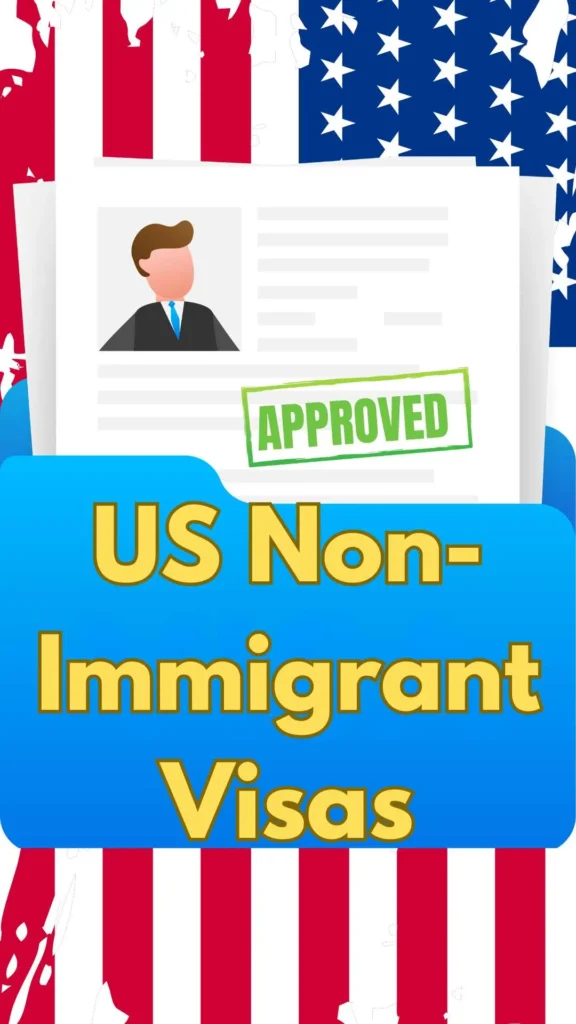US Non-Immigrant Visas: The United States is a wealthy country in every field, including education, career opportunities, work, etc. Its richness attracts many people who always want to visit the US.
Unlike Immigration Visas, US Non-immigrant visas are provided to those who want to live in the US temporarily.
Non-immigrant keys are for people whose primary purpose is youth tourism, education, business, or specialized employment.
US Non-Immigrant Visas
Non-immigrant visas are provided for a short period, and the users of these visas must follow the guidelines and rules.
United States Citizenship and Immigration Services (USCIS) manages all the processes of giving non-immigration visas. It includes counselors and officers.
Categories of US Non-Immigrant Visas
The USCIS provides different types of US Non-Immigrant Visas; here is the list of all types of Non-Immigrant Visa:
A visitor Visa is for those who want to visit the United States for some temporary business purpose or to travel to the United States on vacation.
- B-1 Visa: A temporary visit to the United States for business purposes, such as meeting with a company based in the US.
- B-2 Visa: You can also call it a tourist visa to visit the US for traveling purposes with your friends or family.
Student visa are for those foreign students who want to study in the USA
- F-1 Visa: An F-1 visa is a non-immigrant student visa for international students who want to study at an accredited institution in the US.
- M-1 Visa: An M-1 visa is another type of non-immigrant student visa for international students. Unlike the F-1 visa, it’s specifically designed for those enrolling in non-academic programs.
Exchange Visa
The Exchange Visa is for people participating in cultural and educational exchange programs.
- J-1 Visa: J-1 visas are designed to promote cultural exchange between the US and other countries. Students, teachers, researchers, trainees, interns, camp counselors, au pairs, and more can be participants.
- Q-1 Visa: The Q-1 visa is part of the Exchange Visitor Visa program for international cultural exchange. It allows participants to engage in approved programs that combine work and cultural sharing, spanning fields such as arts, media, or business.
Fiance Visa
- K1 Visa: K-1 visa is also known as a fiancé(e) visa. It’s a non-immigrant visa issued by the United States Citizenship and Immigration Services (USCIS) to the foreign fiancé(e) of a U.S. citizen.
Spouse Visa
- K3 Visa
- CR-1
- IR-1
Treaty Trader/Investor Visa
- E Visa: The Treaty Trader/Investor visa, or the E visa, is a non-immigrant visa category designed to facilitate trade and investment between the United States and its treaty countries. There are two subcategories within the E visa:
- E-1 Treaty Trader Visa: This visa is for individuals who are conducting substantial trade, principally between the US and the treaty country. Trade can include the exchange of goods, services, technology, or data.
- E-2 Treaty Investor Visa: This visa is for individuals who have invested a substantial amount of capital in a bona fide enterprise in the United States. The investment must be operational and generate a significant amount of income.
- E-3 Visa: The E-3 visa is a specific non-immigrant visa for Australian citizens looking to work in specialty occupations in the United States.
U.S. Work Visas
- H-1B Visa
- H-1B1 Visa
- H-2A Visa
- H-2B Visa
- H-3 Visa
- I-Visa
- L-Visa
- O-Visa
- P-1 Visa
- P-2 Visa
- P-3 Visa
- Q-1 Visa
- R-1 Visa
Temporary Work Visa
- H-1 Visas
- H-1B Visa
- H-1B1 Visa
- H-1C Visa
- H-1B2 Visa
- H-1B3 Visa
Intra-Company Transfer Visa
- L Visa:
- L-1A visa
- L-1B visa
Other work Visa
- TN Visa
- I Visa
- R-1 Visa
- O- Visa:
- O-1 visa
- O-1A visa
- O-1B visa
- O-2 Visa
- O-3 Visa
- O-1 visa
- P-1 Visa:
- P-1A visa
- P-1B visa
- C1/D
Extraordinary Ability Visa
- A Visa:
- A-1 visa
- A-2 visa
- A-2 NATO visa
- A-3 visa
Humanitarian Visas/Derivative Visas
- U Visa
- T-Visa :
- T-1 visa
- T-2 visa
- T-3 visa
- T-4 visa
- T-5visa
Diplomatic and Official Visas
- G Visas:
- G-1 visa
- G-2 visa
- G-3 visa
- G-4 visa
- G-5 visa
- NATO Visas:
- NATO-1 visa
- NATO-2 visa
- NATO-3 visa
- NATO-4 visa
- NATO-5 visa
- NATO-6 visa
- NATO-7 visa
USA Transit Visa
- C Visa:
- C-1 visa
- C-2 visa
- C-3 visa
Informants Visa
- S Visa:
- S-5 visa
- S-6 visa
Application Process and Requirements
Different steps are involved in getting a Non-Immigrant visa. The object should fill out the online visa application. DS-160 and pay the required amount.
Also, the object should have the necessary documents, such as passport-size photographs and other technical documents.
During the interview, the thing asked simple questions like the purpose of going US, the requirement of money, etc.
Challenges and Considerations
While the non-immigrant visa system facilitates temporary stays in the U.S., several challenges and considerations exist for applicants:
Stringent Eligibility Criteria
Every visa category differs, including object qualification, experience, financial stability, etc.
Visa Processing Times and Backlogs
Visa processing time is quite different in every visa category and is based on backlog and the workload on USICS.
Changing Immigration Policies
The US government always tries to improve the quality of non-immigration visas, which may cause delays in visa processing or make it easy to get a visa.
Risk of Visa Denials
Visa can be denied because of incomplete documentation, lack of relations in the other country, lack of communication skills, etc.
Conclusion
The continuous improvement in providing US Non-Immigrant Visas showcases the commitment to welcome outsiders into their country through Cultural cooperation, startup cooperation, business development, and international business opportunities.
